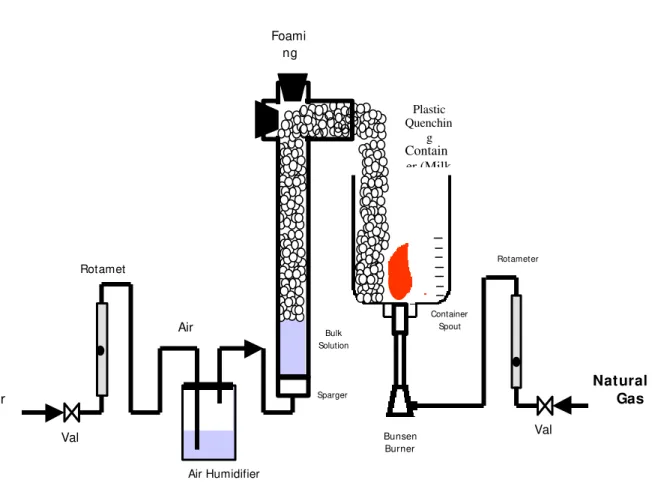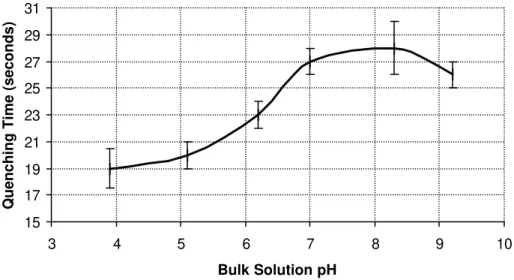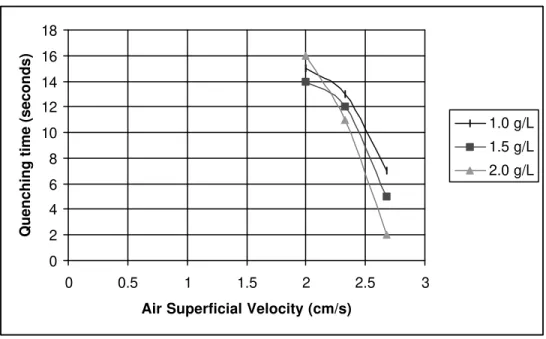Vol.46, n. 4 : pp. 735-740, December 2003
ISSN 1516-8913 Printed in Brazil
BRAZILIAN ARCHIVES OF
BIOLOGY AND TECHNOLOGY
A N I N T E R N A T I O N A L J O U R N A L
Using Egg Albumin Foam to Extinguish Fires
Hytham A. Alsaati, Danielle Ditzler, Vorakan Burapatana and Robert D. Tanner
*Chemical Engineering Department; Vanderbilt University; Fax: (615) 343-7951; rtanner@vuse.vanderbilt.edu; Nashville, TN 37235; USA
ABSTRACT
Oil, coal and chemical fires are often difficult to put out using water. In certain hydrocarbon fires, protein foam can extinguish fires better than water by keeping air (oxygen) away from the flames and by “blowing” the flame away from its fuel source. Egg albumin is a relatively inexpensive protein and is representative of foaming proteins, which are candidates for use as fire suppression agents. This paper begins to deal with the effect of the foam bulk pH, foam protein concentration and generating air flow rate into the foam on the fire extinguishing time in laboratory experiments. A Bunsen burner was used to generate a small, controlled laboratory fire within a plastic container, which represented a point source in a partially open room in the experiments. The Bunsen burner represents a gaseous hydrocarbon fire, which can be difficult to extinguish. Both a low pH foam and one made with a high air flow rate favor a reduction in time required to put out the Bunsen burner flame.
Key words: Protein Foam, Albumin, Fire Suppression, Biodegradable Foams, Natural Gas Flame
INTRODUCTION
“The conventional method of putting out fires using water can be ineffective against liquid fuel fires fed by gasoline, coal or chemicals. Using water to suppress fires can also pose other problems like damage to neighboring electrical appliances and computers. Water is relatively heavy so it may not be suitable for putting out fires in airplanes or spacecraft” (Reisch, 2001), where it must be carried. A partial alternative to using water for fire suppression is to employ fire-extinguishing protein foam (which contains only a fraction of the water used in the former method). Foam can create a barrier between the required oxygen in the air and a flame. Halons are widely used to create fire suppression foams, but halons are ozone depleting
the earth (US Department of Transportation, 2001). The replacement of halons with non-fluorocarbons such as proteins may reduce the rate of ozone depletion.
This paper deals with the feasibility of using egg albumin foam to suppress a gaseous hydrocarbon fire. Egg albumin protein is selected as a representative foaming protein due to its relativly low cost, low-toxicity and biodegradability. Methane is used as the gaseous hydrocarbon fuel.
MATERIALS AND METHODS
pH meter (model No. 5984-50).
The apparatus is depicted in Fig. 1. The foam was formed by passing air through the bulk solution in the column. The glass column was 2.5cm in diameter, 45cm long and contained 100 ml of bulk protein solution initially. The compressed air from the building air line was first passed through a beaker containing water (the air humidifier) before entering the column, in order to minimize the loss of water from the column during the foaming process. The airflow was measured by a rotameter. Following the rotameter, the air flowed through a glass fritted disc sparger at the bottom of the column creating small air bubbles in the bulk fluid. The air superficial velocity (airflow rate divided by the inside cross-sectional area of the column) was varied between 2 and 2.7 cm/s. The fire quenching time, measured with a wrist watch, was the time required to put out the natural gas-fed Bunsen burner flame in a plastic container which was open to foam at the top. The Bunsen burner was inserted into the spout of this bottomless 1-gallon plastic milk jug as illustrated in Fig. 1. The Bunsen burner flame represents a hydrocarbon fire. The flame height was controlled using the natural gas line valve. It was adjusted to two positions in this study: 5 and 10 cm.
RESULTS AND DISCUSSION
A hydrocarbon fire may be easily ignited but difficult to extinguish. It was observed here that at the time the top of the flame was extinguished by foam, a final flash of the flame was emitted from the bottom of the plastic jug. The reference pH of the generated foamate solution (before adding HCl or NaOH) was 6.3. The isoelectric point of albumin is around pH 4.7. The effect of pH on the quenching time for a 5 cm flame is shown in Fig. 2. It was observed that the quenching time decreased away from the peak at pH 6.3 for both acidic and basic foams. For the 10 cm flame it is seen in Fig. 3 that as the pH decreased from 6.3 to 3.9, the quenching time decreased from 23 seconds to 19 seconds. Raising the pH above 6.3 leads to an increase in quenching time up to pH 8.2,
observed that it takes longer to put out a 10 cm natural gas flame than a 5 cm flame at all pH’s using albumin foam and especially for pH’s above 6.3.
Figure 1 - The Experimental Setup for the fire quenching test using egg albumin foam produced in a foam fractionation column
12 15 18 21 24 27
3 4 5 6 7 8 9 10
Bulk Solution pH
Q
u
e
n
c
h
in
g
T
im
e
(
s
e
c
o
n
d
s
)
Rotamet er
Val
Air
Foami ng
Rotameter
Val
Bunsen Burner Bulk
Solution
Plastic Quenchin
g Contain
er (Milk
Air
Natural Gas
Air Humidifier
Sparger
15 17 19 21 23 25 27 29 31
3 4 5 6 7 8 9 10
Bulk Solution pH
Quenching Time (seconds)
Figure 3 - The effect of varying the egg albumin bulk solution pH on the quenching time for a 10 cm flame. The air was passed through a 1 g/L albumin solution at 2 cm/s.
Figure 4 - The effect of varying the egg albumin foam superficial velocity at pH 6.0 and protein concentration of 1 g/L on the quenching time for a 5 cm flame.
0 5 10 15 20
1.5 1.75 2 2.25 2.5 2.75 3
Foam Superficial Velocity ( cm/ s)
Q
u
e
n
c
h
in
g
T
im
e
(
s
e
c
o
n
d
s
Figure 5 - The effect of varying the egg albumin foam superficial velocity at pH 6.0 and different bulk solution concentrations on the quenching time for a 5 cm flame.
Use of egg albumin foam was found to be an effective method for natural gas fire suppression in a confined space. It successfully pushed the fire away from the source and prevented air from reaching to the flame. Here, the plastic milk jug (with the bottom cut off) served as a laboratory model for a room. The Bunsen burner served as a point source of a fire flame within the room. The quenching time for a 5 cm flame can be reduced from as much as 21 seconds to 2 seconds by adjusting the foam pH, air superficial velocity and albumin concentration.
CONCLUSIONS
The fire quenching time depended directly on the pH, air superficial velocity, and concentration of the albumin bulk solution for a given Bunsen burner flame height. A low pH, a high superficial velocity and a concentrated bulk solution together are one combination for rapid fire suppression using an egg albumin foam.
RESUMO
Chamas produzidas por óleo, carvão e produtos químicos (incêndios provocados) são difíceis de ser extinguidos com água. Algumas chamas de hidrocarbonetos podem ser extinguidas por espumas protéicas melhor do que a manutenção de ar (oxigênio) fora do alcance das chamas ou pelo sopramento da chama para longe da sua fonte. Albumina de ovo é uma proteína relativamente barata e é representativa dentre as proteínas usadas como espuma para a (supressão) extinção de agentes causadores de incêndio. Este artigo trata do estudo do efeito do pH e concentração da espuma protéica, além da geração de ar no interior da espuma, sobre o tempo de extinção de incêndio em experimentos laboratoriais. Nos experimentos um bico de Bunsen foi usado para gerar uma pequena chama, controlada em um container de plástico, representando uma fonte pontual em um ambiente parcialmente aberto. A chama do bico de Bunsen representa uma chama gasosa de hidrocarbonetos, que são difíceis de ser extintas. 0
2 4 6 8 10 12 14 16 18
0 0.5 1 1.5 2 2.5 3
Air Superficial Velocity (cm/s)
Quenching time (seconds)
1.0 g/L
Reisch, M.S., Taking Care of Business. Chemical and Engineering News. April 2, 2001, 17-25
US Department of Transportation, Option to the Use of Halons for Aircraft Fire Suppression Systems 2001 Update, March 2001, DOT/FAA/AR-99/63.


